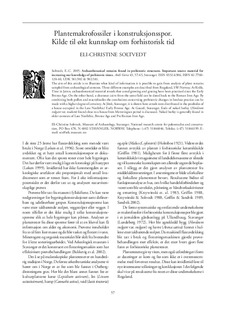| dc.contributor.author | Soltvedt, Eli-Christine | |
| dc.date.accessioned | 2013-05-10T11:43:22Z | |
| dc.date.available | 2013-05-10T11:43:22Z | |
| dc.date.issued | 2005 | |
| dc.identifier.citation | Soltvedt, E.C. (2005) Plantemakrofossiler i konstruksjonsspor : kilde til økt kunnskap om forhistorisk tid. In : Høgestøl, Mari (red.) Konstruksjonsspor og byggeskikk : maskinell flateavdekking - metodikk, tolkning og forvaltning. Stavanger : Arkeologisk museum | no_NO |
| dc.identifier.uri | http://hdl.handle.net/11250/181500 | |
| dc.description.abstract | The aim of this article is to illustrate what kind of information it is possible to gain from analysis of plant remains
sampled from archaeological contexts. Three different examples are described from Rogaland, SW-Norway. At Kvåle,
Time in Jæren, archaeobotanical material reveals that cereal growing and grazing have been practised since the Early
Bronze Age. On the other hand, a clearance cairn from the same field can be dated back to the Roman Iron Age. By
combining both pollen and macrofossiles the conclusions concerning prehistoric changes in landuse practice can be
made with a higher degree of certainty. At Jåttå, Stavanger, it is shown how cereals were distributed in the postholes of
a house occupied in the Late Neolithic/ Early Bronze Age. At Gausel, Stavanger, finds of naked barley (Hordeum
vulgare var. nudum) found close to a house from Merovingian period is discussed. Naked barley is generally found in
older contexts of Late Neolithic, Bronze Age and Pre Roman Iron Age. | no_NO |
| dc.language.iso | nob | no_NO |
| dc.publisher | Arkeologisk museum i Stavanger | no_NO |
| dc.relation.ispartofseries | AmS-Varia;43 | |
| dc.subject | botanikk | no_NO |
| dc.subject | makrofossiler | no_NO |
| dc.subject | naked barley | no_NO |
| dc.subject | Stavanger | no_NO |
| dc.title | Plantemakrofossiler i konstruksjonsspor : kilde til økt kunnskap om forhistorisk tid | no_NO |
| dc.type | Chapter | no_NO |
| dc.subject.nsi | VDP::Humanities: 000::Archeology: 090 | no_NO |
